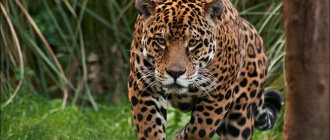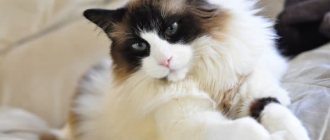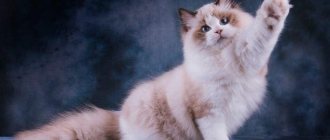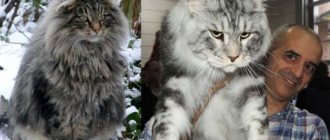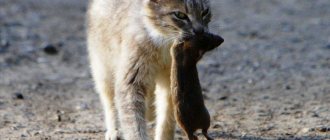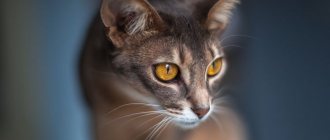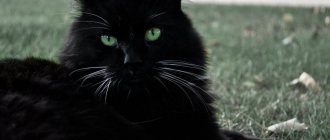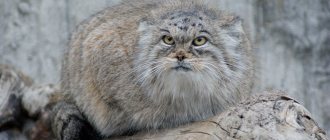Now we’ll tell you which cat breeds are the most evil.
The leading and at the same time permanent place in the ranking of the Top 10 evil cat breeds belongs to Siamese cats, terrible jealous cats and hunters.
You wouldn’t guess from the angelic blue eyes and beautiful coloring that the owner of cute features is vengeful, holds a grudge for a long time and is capable of inflicting reprisals on the offender at the most inopportune moment.
Oriental
Oriental cats are next on the list of the most evil breeds. They are very capricious, selfish, deciding everything and always for the whole world. They are fast and energetic, they do not like being forced to be affectionate or being ignored. If you don't notice their ears, you risk getting a depressed cat in the house who will behave vindictively and disrespectfully, marking in slippers and making marks on wallpaper and furniture.
The Siberian cat is independent and proud, not tolerant of affection.
The Siberian cat has a fairly large build with a fluffy face and thick hair. It is believed that this breed originated from the crossing of a domestic cat with wild species of the cat family. The weight of the female reaches 6 kg, and the weight of the male can reach 12 kg.
The character is very independent. The Siberian cat does not like unexpected displays of affection from its owners.
Read the full review of the large cat breed - Siberian.
Bengal cat
It is no secret that Bengal cats were bred by crossing domestic cats and wild ones. Therefore, in the character of this breed, the temperament of a gentle domestic cat and the burrows of a real wild, unbridled predator are intricately crossed with each other.
In normal circumstances, Bengals are quite calm and serene animals, whose behavior is no different from other domestic cats. However, if it seems to them that there is danger somewhere nearby, the hunting instinct takes over. Therefore, Bengal cats can seriously harm humans.
It is also worth noting that this breed is practically not trainable.
Snow Shu
A breed called Snow Shoe is not very widespread. This is due to their restlessness, which makes them want to hunt for something or someone, play pranks, and having received punishment, hide and take revenge on a harmful person. Cats - “snowflakes” are smart, can open locks and doors, manage, scatter and hide small change.
Owners say that when Snow Shu raises his voice, he can hit a loud person with his paw. So, think three times before getting such a pet.
London in touch
In fact, London has nothing to do with it. But the British Shorthair is included in the ranking of the most evil cats. And you can’t say this at all, looking at the round face with wide open eyes. The British have a unique character. They do not tolerate disrespectful behavior towards them. These cats are generally not known for their patience. They are quite demanding and at the same time independent. Although the British breed is characterized as particularly attached to its owner.
Ural Rex
This breed first gained popularity in pre-war times. But after the war, the number of these cats decreased, and for a long time they were considered to have disappeared forever.
But in the 60s, it became known about Ural Rex breeders, and the myth about the disappearance of the breed was dispelled, although the breed is still considered quite rare.
People who buy a handsome Ural cat most often think about its unusual appearance, but do not think at all about the unpredictable nature of this cat.
Most often, such cats behave quite friendly and affectionately, but at any moment the cat’s behavior can change in a sharply negative direction. So owners and their guests should beware of sudden bites from their pet.
Bengal
Another representative of the evil cat family is the Bengal, with a pronounced hunting instinct and incredibly impressive appearance. Many of the representatives of the Bengal breed have impulsive character traits, due to which the animal becomes aggressive, capable of even attacking the owner in case of contradictions.
Raising your voice, much less shouting, is not tolerated. Day after day, Bengals tirelessly drive everywhere, and this continues until old age. Not everyone will like this. If the owner does not want to get a pet that will constantly attack him, he needs maximum attention, affection and care for the representatives of the breed.
Features of aggression
Bombay cat - description of Bombay cats
It is easy to recognize the appearance of aggression in a cat of any breed. Characteristic signs include nervous tail wagging, ears pinned back to the head, dilated pupils and hissing.
The cat is hunting
You should also be wary of the fact that she is trying to hide or presses herself to the floor to attack her owner. For some time it is better not to approach her and not get into her field of vision. If such a problem arises, then you should not treat it negligently. As a result of this behavior, sleep disturbances, decreased immunity may occur, and ultimately, the cat will become very irritable and will not be able to control its aggression.
Chausie
The chausie is also not of the kindest disposition; it is wild and capricious, slightly reminiscent of a puma in appearance. The chausie is distinguished by its size and highly developed hunting instinct. There is no place for them in a small apartment because of their large dimensions and desire to run around, their love of occupying mezzanine and above closet spaces, creating reserves and secret storage areas, which the owners will periodically access.
Abyssinian
The Abyssinian cat is an ancient breed. Her character resembles that of a dog. She is very active, playful, extremely energetic and easy to train. The Abyssinian has a hard time with loneliness and is prone to depression. Like representatives of the Siamese breed, Abyssinian cats can take revenge on household members for grievances caused. They can bite and scratch painfully.
Siamese cat
Siamese cats are considered one of the most beautiful in the world. This breed is very popular not only because of its beautiful appearance, but also because of its high intelligence.
These cats are very smart and easy to train. They are easy to train and even loyal to humans. But in addition to high intelligence, these cats also received phenomenal memory.
Once the owner offends a Siamese cat at least once, he will remember it forever. And not only will he remember, but he will also want to take revenge at the moment when the enemy is unarmed.
There are many examples of Siamese cats attacking their owners while the latter were sleeping in bed. Therefore, you should not offend Siamese cats or treat them unfairly.
Cathesian
Not the most common, but one that ranks among the top evil cat breeds is the Chartreuse or Cathesian. Cats of French origin are extremely jealous, considering themselves the only ones they love. They cannot stand competition, they do not want strangers and are afraid of them, and for this reason they do not get along with other pets at all. Their capricious nature also requires space for maintenance; a private house is perfect.
Self-sufficiency, impatience with changes in daily routine and habitat, and reluctance to forced hugs make Chartreux not the most desirable family members. But if they really love the owner, they will show him their affection in every possible way and seek attention.
Top 10 most evil cats - Which purebred cats are the most aggressive? Review + Photos and Videos
Most people think of cats as fluffy, purring, and the cutest animals. Until someone's razor-sharp claws grab their hand.
Or biting teeth. Or the first and second at the same time.
Now we’ll tell you which cat breeds are the most evil.
The leading and at the same time permanent place in the ranking of the Top 10 evil cat breeds belongs to Siamese cats, terrible jealous cats and hunters.
You wouldn’t guess from the angelic blue eyes and beautiful coloring that the owner of cute features is vengeful, holds a grudge for a long time and is capable of inflicting reprisals on the offender at the most inopportune moment.
Little lynxes
The jungle cat can be placed in second place in terms of aggression towards humans. This animal is very beautiful, its appearance resembles a lynx. Just without ear tassels. However, beauty is beauty, and the character of these cuties is simply brutal. Not only does the weight of an adult cat reach 15 kg, but its wild habits remain. Such a miracle will begin a hunt for its owner and seriously injure it.
jungle cat
Jungle cats are still considered wild, despite the fact that more and more people are expressing a desire to have a representative of this breed at home.
People are most often captivated by the resemblance of this unusual cat to a lynx. The charming tufts on the ears and the massive size of the jungle cat certainly look beautiful.
But nevertheless, the natural predatory habits of the breed make themselves felt, and experts generally advise against keeping a jungle cat at home because of its evil and unpredictable nature.
Attention! People who have small children living in the house should especially beware of purchasing this breed. Taming a jungle cat is no easier than taming a lynx or a cheetah
Savannah
On the pedestal of the most evil cats, the first place belongs to the Savannah, the most aggressive with the genes and blood of wild African servals. Although breeders believe that their work has resulted in a balanced and sweet animal. Savannah especially does not tolerate strangers if it goes for a walk on a leash with its owner - it may well attack a passerby if it considers him dangerous.
Breeders often keep Savannahs in enclosures, since they are quite large cats; if the animal shows aggression, it is removed from breeding. Strangers and pats on the back are two factors that can lead to an angry state, accompanied by hissing and the desire to scratch and bite. Be careful with the savannah!
In the end, we note that, as with affectionate breeds, so with angry ones, the character is determined by upbringing, affection, and care. If, after all, the animal is aggressive, then think about the reason for this behavior. Maybe a stressful situation? Or contact-coercion on the part of the owner? Be patient, attentive and allow the animal to trust you.
The most evil cat breeds
The following breeds are considered to be the most obstinate and difficult to handle:
- Maine Coon;
- Balinese cat;
- British cat;
- Scottish cat;
- Manul;
- Jungle cat;
- Savannah.
Maine Coon
Recently, cats of this breed have become very popular. Most likely, this is due to the unusual appearance of the animal and large dimensions (compared to the average yard cat), which make it possible to compare a representative of the breed with a dog.
Maine Coon family
Unfortunately, very few owners are able to handle a Maine Coon. The reason for the discord is not the negative character traits of the pet, but its obvious difference from the domestic cat. Representatives of the breed have the following characteristics:
- Maine Coons need periodic walking. By nature they are hunters, therefore it is vital for them to get rid of accumulated energy;
- Maine Coons will not bask on their owner’s lap, emitting a pleasant purring, if only because they will not fit on them;
- Maine Coons love water treatments, so they are sometimes not averse to trying to take a bath in a bowl of water or splashing it all over the apartment;
- Like dogs, Maine Coons love to dig the ground or anything that comes under their paw, be it sofa upholstery or wallpaper.
Maine Coons need walks in the fresh air
A person thinking about purchasing a Maine Coon should think in advance about the material damage that the pet can cause to him.
Balinese cat
Balinese cats are considered natural extroverts and explorers. They are interested in everything that happens around them; such animals do not like remaining in quiet solitude. A key feature of the Balinese is their talkativeness. Spending time with these animals, sooner or later you will learn to recognize the entire wide emotional spectrum of their exclamations.
Balinese cat
Balinese cats will not tolerate indifference from the owner towards their person. They will require quite a lot of attention in order to feel comfortable and not take revenge on their owner. In this regard, it is not recommended to have Balinese breeds for people who work long hours and do not have free time.
Representatives of this breed are also distinguished by their hyperactivity. They can conquer those heights in your apartment that seemed completely inaccessible. Therefore, when leaving the balinese in the apartment for the day, it is advisable to remove all breakable, breaking and cutting objects away.
Balinese cats are in perpetual motion and searching for new things.
You can find more detailed information about the features of keeping Balinese cats in a separate article on our portal.
British cat
The character of British cats has features of mystery and unpredictability. The behavior of the breed is very difficult to describe in a nutshell. If we select a set of traits that characterize the British most accurately, then let these be the following definitions:
- independent;
- wayward;
- proud;
- reserved;
- patient;
- prudent;
- stubborn.
British cat
All the qualities listed above should not scare you away. With the right approach, a British cat will be glad to have your company and will pass the time with great pleasure in his master's arms or lap. However, it is with the British that a sense of proportion becomes extremely important. Representatives of the breed will not tolerate intrusiveness on your part, therefore, in relations with such cats, it is important to respect personal boundaries, and then the British will certainly return the favor.
British cats never lose their dignity
The British breed's reserve, mistaken for primness, makes them ideal pets for owners who don't confuse a cat with a plush toy that can be cuddled at any time. British cats come to their owner exactly when they want to see him and need his attention. Demonstration is absolutely not characteristic of these animals, and in the owner they want to see, first of all, a friend with whom they can communicate as equals.
By the way! There is an opinion that long-haired British cats are more flexible than short-haired ones.
Longhaired British cats have a softer disposition
Scottish cat
Despite the fact that many breeders describe Scottish cats as real angels, the reality is more prosaic. Therefore, the legend that the Scots are not capable of experiencing aggression at all should be immediately dismissed as a pipe dream. It should be noted that reviews regarding representatives of the breed are distinguished by their inconsistency. Therefore, the question of what kind of character the cat you bought will have remains open.
Scottish cat
Among the negative traits, most owners of Scottish cats identify the following:
- demonstrativeness - the Scots love it when the public’s attention is focused only on them, and if there is a lack of it, they resort to a variety of tricks;
- rivalry - a Scotsman will take any cat or other animal under the same roof as a rival in the fight for admiring glances and “applause.” Therefore, it will be very difficult for owners keeping several animals;
- affection - if the British know a lot about personal boundaries, then some Scottish cats can completely ignore this principle and follow their owner everywhere;
- persistence – some Scots need really tough but fair owners who will teach their pet the word “no”. Otherwise, representatives of the breed grow up to be spoiled and scandalous “persons”.
Scottish cats are very easy to spoil and difficult to retrain.
Manul
Before we begin to describe the character traits of this animal, we should immediately mention the fact that the Pallas's cat cannot be domesticated. He does not mistake a person for his owner and can show aggression towards him, which risks ending in causing quite serious injuries to the owner. Moreover, these animals identify humans with the enemy, and therefore the Pallas' cat begins to irreconcilably defend their territories, even if formally they are not in any danger.
Manul
In captivity, Pallas' cats are kept in zoos or nature reserves, where the cats feel good and actively reproduce. In the absence of danger, representatives of the breed are not characterized by increased aggression - they are calm animals that do not like fuss and noisy companies, preferring to do everything alone (even suffer from diseases). Pallas' cats lead a solitary lifestyle, like many wild cats, making an exception only for mating once a year.
Pallas cats are not intended for home keeping
The characteristic features of this breed include the following:
- Each manul has its own territory, which it is ready to defend until the very end. These wild cats will not tolerate strangers;
- Pallas' cats feed mainly on meat, be it rodents, birds or hares;
- Females have well-developed maternal instincts, while males leave them immediately after mating. In one litter, a Pallas's cat gives birth to from two to six kittens.
You can read about how possible it is to domesticate the Pallas's cat in a separate article on our portal.
jungle cat
Along with the Pallas cat, the jungle cat is also an exotic representative of the cat family, which is unlikely to be domesticated. This breed is listed in the Red Book, therefore it is extremely difficult to acquire a representative of it. Moreover, you will not find jungle cats from official breeders, since they are prohibited from being raised for sale.
Jungle cat in natural habitat
Being wild, jungle cats have a very difficult time getting used to their owner, if at all. As in the case of Pallas cats, jungle cats are unable to see the owner in humans. In addition, the conditions of private houses, and especially apartments, are not suitable for representatives of the breed, accustomed to the spacious banks of rivers and lakes overgrown with bushes.
If you want to keep a jungle cat, the potential owner will face a number of difficulties:
- jungle cats will constantly strive to escape into freedom. If they are kept in a suburban area, it will be quite difficult to keep them;
- There are no ready-made dry foods intended for representatives of this breed. In this regard, the owner of the animal will have to constantly provide it with fresh, raw meat. Moreover, the portions required by the jungle cat are significantly larger than the portions consumed by ordinary domestic animals;
- jungle cats reach about a meter in length, which makes it difficult to keep them in small areas;
- It is unlikely that veterinarians will be able to provide adequate care to a jungle cat that they have never encountered.
It is extremely difficult to purchase a purebred cat from a breeder.
Savannah
The blood of both wild and domesticated ancestors flows in the veins of Savannah cats, so representatives of the breed are somewhere in the intermediate stage between rebellion and tameness. In this regard, despite the fact that Savannah allows the presence of a person nearby, she is most suitable for keeping in an enclosure, which allows her to maintain the necessary distance.
Savannah
Many Savannah owners prefer to compare these cats with dogs, since they absolutely need a walk, during which the animal can spend its accumulated energy. Representatives of the breed quickly get used to the leash and do not try to chew through it. Considering that these cats can jump two and a half meters in height, apartment conditions are completely unthinkable for them.
A person who takes a Savannah cat into his home needs to be prepared for the following habits:
- The cat does not quickly get used to people, and distrusts any stranger. Therefore, if you often bring guests to your house, this can cause stress and desperate attempts to defend your territory from the animal;
- as Savannah grows up, she takes on more and more traits of a wild animal and may clash with some family members;
- Due to their unpredictable behavior, Savannah cats are strictly not recommended for families with small children;
- It is also difficult to predict the outcome of a Savannah cat meeting a puppy or kitten. In the worst case, a representative of the breed may act like a hunter and start chasing the cub.
Savannah takes root well in private homes with a spacious yard and aviary.
Top 10 dangerous breeds
In addition to peaceful and friendly cat breeds, there are also those that are endowed with a willful and cocky disposition. Such pets are poorly adapted to living together with people and, under certain circumstances, become very aggressive and unsafe. When enraged, these cats can cause no less harm than a poisonous spider or an angry dog.
The list of the 10 most dangerous breeds includes:
- savannah;
- manul;
- Abyssinians;
- Siamese;
- Maine Coon;
- British;
- Siberian;
- Bengali;
- chausie;
- reed
Savannah
These large graceful animals are considered one of the most dangerous cats in the world. Although Savannahs can be tamed, there is always a risk that they will become aggressive.
The owners of these cats must always be on alert, because their graceful pets often perceive strangers as objects of hunting.
Manul
This wild feline is similar to a lynx and is completely untamed. Even a manul raised in captivity will avoid people. These aggressive and dangerous cats are not suitable for home keeping.
No matter how hard you try, it is impossible to teach wild Pallas’ cats commands and stop them from damaging their owner’s property.
Abyssinians
These sophisticated oriental beauties also belong to the category of dangerous cats. It turns out that representatives of the breed are very vindictive and immediately take revenge for insults inflicted on them. Without proper attention, Abyssinians become wild and aggressive.
Siamese
These cunning and dangerous cats are very aggressive and vindictive. They can harbor a grudge for a long time and take revenge at the most unexpected moment. Siamese cats do not like excessive attention and do not tolerate familiarity. It is not advisable to take representatives of the breed into families with children.
These cats pose a real danger to children who do not yet know how to properly handle a pet.
Maine Coon
These smart and flexible animals are endowed with a changeable disposition and can begin to take revenge even for a minor offense. Large and dangerous Maine Coon cats cannot stand loneliness and, due to their size, are capable of crippling a person.
British
This cute domestic cat is endowed with an independent and willful character. The proud and freedom-loving Briton has no love for strangers and prefers to distance himself from them. He can hardly tolerate being picked up or forced to play.
Siberian
This large and quite dangerous cat is wary of strangers and can only get along with someone who has a highly developed sense of self-esteem.
An independent and strong Siberian can be both affectionate and sensitive, and aggressive. To smooth out developed hunting instincts and avoid unwanted behavior, this cat must be trained from an early age.
Bengal
This impulsive and dangerous cat has highly developed hunting instincts. To prevent a Bengal kitten from becoming an aggressive monster, it is raised in a calm atmosphere.
An active and mobile animal does not like to be forcibly held in arms and does not tolerate being addressed in a raised voice. An angry Bengal cat can be unsafe and capable of causing serious damage.
Chausie
These powerful animals, more like a puma, also belong to the category of aggressive and unsafe breeds. Aggressive cats need to be dealt with constantly and dangerous games should not be played.
Chausies have developed hunting instincts, do not tolerate confined spaces and are not suitable for apartment living.
Reed
This aggressive and dangerous cat with the appearance of a lynx is practically impossible to domesticate and is difficult to train. She needs constant communication, and if there is a lack of it, she quickly runs wild.
Chayzy
Chayzie is one of the expensive and extravagant cat breeds, which is a cross between an ordinary domestic cat and a swamp lynx. She is independent, even arrogant, and has a disobedient and obstinate disposition. Between the owner's knees and exploring the territory, the chayzi will certainly choose the latter. She is smart, active, and has a developed intellect. But with a lot of advantages, it can be extremely aggressive. If you have ever offended such a beauty, have no doubt: she will definitely remember the offender and take revenge.
Maine Coon
Of the domestic cats, the largest is the Maine Coon, which has a massive body and a wide chest. A non-obese Maine Coon can weigh up to 15 kg. They are often bred as exotic cats. But they may not be harmless, sometimes they can show aggression, and the large size of the cat can mean more serious injuries. If a stranger enters the territory of the house, the Maine Coon may meet him aggressively. But at the same time, breeders note their flexibility and high intelligence - Maine Coons can pick up on the intonations of their owners and respond to their requests. They are very curious and therefore require close attention to themselves. They don’t like to be left alone, so if a Maine Coon needs to be left alone for a while, then you should provide it with toys, otherwise the owners will later regret leaving it. Maine Coons do not require special conditions to keep; they feel good in any climate. But during walks you should not leave them alone, as their mood can instantly change.
Manul
Manul is one of those breeds that cannot be tamed. These cats are too freedom-loving and will never obey a person.
It is worth noting that the disobedience of the Pallas cat is primarily due to the fact that he is not a domestic cat, but a wild one. That is, these cats feel very comfortable living in natural conditions, but they are not adapted to living side by side with humans.
As soon as the manul senses danger, he will immediately attack the person. Its claws are considered very powerful by feline standards, and its fangs are 3 times longer than those of an ordinary cat. It is worth noting that Pallas cats not only behave aggressively, but also look quite menacing.
